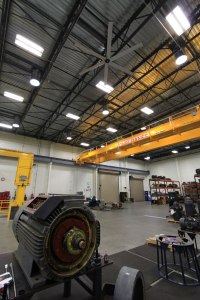HVLS Fans
 For hundreds of years, people residing in warm weather areas have utilized the cooling abilities of slow-moving air. In British India, servants would manually propel overhead circling fans called punkas; large ceiling fans were used in pre-Civil War southern mansions. Southern mansions before the Civil War used large ceiling fans, and servants in British India would manually operate overhead fans called punkas. Fans quickly became motorized as electric motor technology improved. Engineers first increased the speed the fans would move at, trying to increase cooling power by increasing air displacement. However, any speed faster than a gentle breeze could be unpleasant, drafty, and even disruptive. There isn’t much cooling benefit to air propelled faster than five miles an hour. And actually, in hot conditions with low humidity, slow-moving air is the best for ventilating and cooling.
For hundreds of years, people residing in warm weather areas have utilized the cooling abilities of slow-moving air. In British India, servants would manually propel overhead circling fans called punkas; large ceiling fans were used in pre-Civil War southern mansions. Southern mansions before the Civil War used large ceiling fans, and servants in British India would manually operate overhead fans called punkas. Fans quickly became motorized as electric motor technology improved. Engineers first increased the speed the fans would move at, trying to increase cooling power by increasing air displacement. However, any speed faster than a gentle breeze could be unpleasant, drafty, and even disruptive. There isn’t much cooling benefit to air propelled faster than five miles an hour. And actually, in hot conditions with low humidity, slow-moving air is the best for ventilating and cooling.
For a long time, cooling large spaces required multiple, smaller high-speed fans that individually weren’t capable of enough coverage for a wide area. The high-speed fans required ongoing maintenance and were not very energy-efficient. Things changed in 1995, however, after a race car designer and mechanical engineer named Walter Boyd developed the High Volume Low Series fans, or HVLS fans. Commercial, industrial, agricultural or other large spaces now had a more efficient alternative.
Relying on HVLS warehouse ceiling fans for cooling large spaces may still be a lesser known option for designers who are overly reliant on HVAC systems. Because of their cleverly designed aerodynamic blades, they are both efficient and very effective. A fan’s efficiency is measured by the time it takes to move a certain amount of air,measured in cubic feet, and comparing it to what other cans can do for the exact same time.
HVLS fans are suitable for use in places with large, open spaces; ceiling heights should be at minimum, 15 feet tall. Studies show that HVLS fans are the most energy efficient among the air circulating fans on the market. While HVLS fans use their size to increase air displacement, a traditional high speed requires increasing its speed to move more air. The power needed to drive the fan is equal to the cubed value of the speed of the fan.
So 8 times the amount of power must be provided in order for a fan to double its speed; in the case of high speed fans, that means 8 times the amount of electrical power. For a quick example, consider a high speed commercial fan capable of delivering air at 20 miles per hour; it requires 64 times the electrical power than a fan delivering air at five miles per hour. The large size of the industrial shop fans make it possible to move sizable amounts of air at low speeds, without requiring the additional power or speed. Additionally, for warmer months in places without air conditioning, the slow-moving air created by an HVLS fan is more apt to break up the moisture-rich layer that can surround people, leading to a cooling evaporation.
- Posted in: Uncategorized
